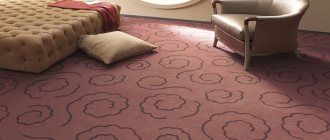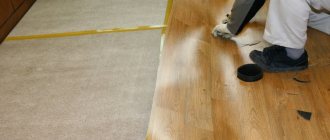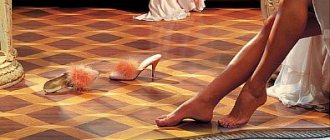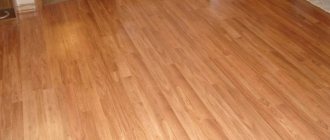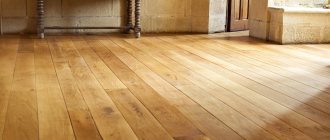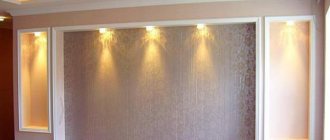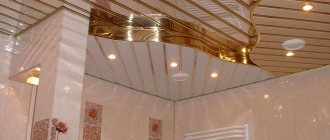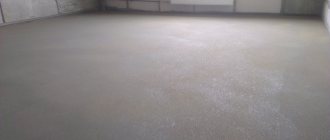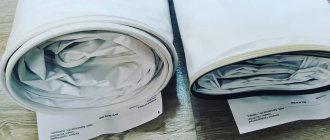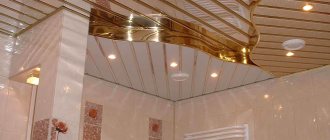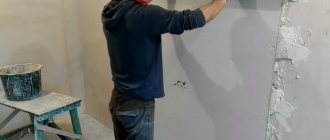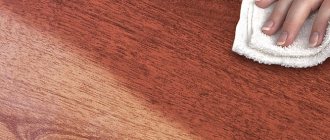Laying carpet is not as easy a task as it might seem. Each of the many known methods has its own subtleties, and it is very important to be able to choose exactly the one that is needed in a particular situation.
The type of carpet and its service life depend not only on its choice, but also on the quality of its installation. High-quality carpet installation can be done independently only if all rules are followed. To do this, it is necessary to familiarize yourself in detail with the properties of this coating and analyze possible installation schemes. Therefore, before laying carpet, you should know all the steps. The carpet is laid after the finishing work is completed.
Parquet, linoleum, and concrete can be used as a base. No special preparation is required before laying carpet, but you will still have to comply with some conditions:
- the base under the carpet must be hard, clean, level and dry;
- the material itself must first be acclimatized - for this it is stored for 24 hours in the room where it is supposed to be laid;
- The following conditions must be maintained in the room:
- minimum air temperature – 15°С,
- minimum temperature of carpet and glue – 17°C,
- maximum relative humidity – 75%.
Between the base and the carpet you can place a backing - a thin layer of porous material: polyurethane foam, polyethylene foam, felt and others.
Flooring methods
Carpet installation can vary. The choice of a specific method depends on the purpose and size of the room. But in order to make a final decision, you need to take into account the manufacturer’s recommendations. So, here are the styling technologies that exist:
- Without attachment to the base. This method is called free flooring; people may hear it as laying carpet under the baseboard. Suitable for small residential spaces with low traffic. The covering is simply laid and pressed against the baseboards. Ideal for quick replacement, but preferably placed in one piece. There's a problem with the joints. Some types (on a felt basis, for example) can “slide” under your feet.
Carpet installation - an inexpensive solution to update your design - Fastening with double-sided tape. It’s hard to even call it a mount. You need good double-sided tape, which is glued around the perimeter of the room, making several stripes in the middle. If there is a joint, glue along the joint.
- Pulling on the gripper. This is a bar with points. It is nailed/glued around the perimeter of the room. The covering is hooked onto the hooks, covering the slats with a plinth. Also a very quick and trouble-free replacement, but normal installation requires special tools. Although you can try it manually, a good result is not guaranteed.
Advantages and disadvantages of different methods of carpet installation - Gluing. It is used in areas with high traffic intensity, where there is furniture on wheels or for large rooms. However, it is advisable to lay some types of carpet only with glue. For example, on a felt basis. It is most susceptible to stretching and has a slippery base.
There is one more point. It is recommended to lay a special underlay under the carpet. Even if a covering with a very short and dense pile is used, some substrates will give a feeling of softness - when the foot “sinks” into the covering. But this is not the main thing. The main thing is that when using a carpet underlay, the service life of the coating almost doubles. And another plus is increased sound insulation.
↑ We take measurements
So, we’ve decided on the type of carpet to choose, which means it’s time to start doing the calculations. The footage is calculated as follows:
- we measure the area of the room, create a sketch on which the location of arches, doors, stairs, columns is noted;
- if the carpet is not a single sheet, but a roll, then determine the length and number of stripes;
- add 5 cm to the length of the first stripe, and add the length of the repeating pattern from the second stripe.
It is important! Experts recommend adding about 10% to the result obtained.
You should take into account not only the geometric shape of the room, but also the absence or presence of niches under the window sills and the width of the carpet.
Carpet underlay - types, choice
If you want to have a soft, cozy floor on which you can not only walk, but also sit and lie on, it would also be nice to lay a backing under the carpet. This layer makes it possible not only to get a soft floor, but also to make it easier to remove the coating and change it. And if a dense and thick underlay is laid, it will also improve sound insulation. Not dramatically, of course, but it will be quieter.
Laying carpet with backing takes place in two stages. First, the substrate is glued to the prepared base. After it has dried, the coating is laid. There can be any method of fixing the carpet to the backing. Again, it depends on the load and the presence of furniture on wheels, the need for replacement, etc.
Carpet underlays can be made of different materials with different properties
The substrate can be:
- textile;
- felt (natural felt or synthetic);
- reinforced;
- foamed vinyl;
- polyurethane foam materials;
- rubber (corrugated or flat).
In principle, you need to select according to a set of characteristics, but it is important that the substrate is elastic. It’s easy to check its elasticity: you need to crush it. If it crumples up without effort, it won’t fit. If you managed to squeeze only slightly and after removing the force it immediately returned to its previous shape - it’s normal. Some types of substrates (rubber, for example) cannot be wrinkled at all. But it also depends on the thickness. Optimal for home and apartment - 0.65-1.00 cm.
Various thicknesses and densities, from a variety of materials
By the way, if you have linoleum laid on the floor and it hasn’t come off, hasn’t come off in waves, but has simply lost its appearance or become boring, it can also be used as a backing. I mean, it doesn’t have to be deleted.
How to lay carpet on linoleum? Yes, in any way. Carpet with a rubberized layer can be laid using any method. Even if it’s just secured with tape. It is better to glue softer felt-based options, but not with glue, but with a retainer (read below).
Features and nuances of the material
Carpet is very durable, but its service life will largely depend on proper installation and careful care. And the main disadvantage of carpet is that bright chemical dyes are used in its production, which in certain situations can cause allergies in the residents of the house. Therefore, the material is not recommended for use in apartments where environmentally sensitive people live. However, we should not forget that the carpet itself is a good accumulator of dust, and the resulting allergy may not be caused by dyes, but by these tiny particles of debris. With regular cleaning of the coating there should be no allergies.
Carpeting (carpet) is a pile product intended for laying on the floor and occupying the entire perimeter of the room
They say that carpet is capable of releasing substances into the air that negatively affect the human body. And here it’s worth thinking, first of all, about what the material is made of. If it is made of pure wool, then there is no need to worry about inhaling toxic substances. And if the material is synthetic, then it is worth remembering that the same linoleum or laminate contains much more toxic adhesives and substances than the same carpet.
Base requirements
In order for the carpet to serve for a long time and not lose its appearance, it must be laid on a flat base. Since the coating is “hairy” and elastic, there are no special requirements for evenness. The coating will follow the contours of the base. But in places where there are sharp changes, abrasions form after a while - here the coating is subject to increased wear. To prevent this from happening, here's what to avoid:
- Sudden changes in height - steps, holes.
- Unstable foundation.
- Dust, debris, sand.
Preparing the base for laying carpet
All these shortcomings can be easily eliminated. With dust and debris, everything is generally clear - thoroughly clean with a vacuum cleaner before installation. It is better to eliminate irregularities. If there are noticeable differences in height, they can be sanded or filled with putty if it is a plank floor or covered with a repair mixture if the base is concrete. If you don’t want to buy repair materials, you just need to mix cement (1 part) with sand (3-4 parts), add a little PVA and dilute with water. But the disadvantage of this composition is that it must be left for at least two weeks so that there is no excess moisture in the base. Repair crews work faster.
If you want to lay carpet on a wooden floor, you must first level it. To do this, it is not necessary to make a concrete screed on a wooden floor. You can sand a board or lay plywood under the carpet. Plywood is expensive nowadays, so any dense and durable sheet material (gypsum fiber board, OSB, etc.) will do.
You can lay carpet on any dry and level base: on a concrete, wooden floor, on laid plywood, OSB and other materials
If you want to lay carpet on a concrete floor, then you don’t have to put anything on the screed if it is dry and level. But for a more comfortable feeling, you can use a backing or lay plywood. If it's just a concrete slab, it needs to be leveled somehow. If necessary, you need to take care of waterproofing.
Frequently asked questions
Inexperienced people always have many similar questions. Some of them can be answered in advance, without waiting for them to arise:
What glue is best to choose for laying carpet in the rooms of a typical apartment?
It is recommended to use dispersed compositions or acrylic-based adhesives. They do not smell, which is very important for residential premises.
What is the best way to lay the canvas, along or across the room?
This is not important. Usually they work in the way that is most convenient in a given room. However, if the wall has many protrusions, it is better to start on the opposite, flat side.
Is it possible to roll out the canvas with a regular paint roller?
This is undesirable, as the pile comes out and sticks to the carpet. Cleaning the coating after this is not easy, the hairs are poorly absorbed by a vacuum cleaner, you have to remove them manually with a damp cloth. You need a special roller with a hard surface. As a last resort, the paint roller can be tightly wrapped with nylon rope.
Is it possible to install carpet without removing the already installed baseboard?
It is possible, but you will have to act extremely carefully. Trimming the canvas will have to be done with pinpoint precision, otherwise the coating will look sloppy.
Does it matter whether carpet is installed in summer or winter?
This is not important. Carpet does not change linear dimensions with increasing or decreasing humidity. However, it must be taken into account that when the readings drop to 50%, the canvas begins to accumulate static electricity, which causes sensations.
How to join carpet
First of all, try to make the joint not in an area where people walk or that is constantly in sight; try to calculate it so that most of the joint is under the furniture. If it doesn’t work out, it’s not critical. You just need to make the joint neat. There are two ways to join carpet.
For docking you need a reserve
First way
The first option is suitable for coverings without a pattern and with short pile without loops. We carry out the cutting already on site - after we have laid out the covering “at the permanent place of registration”. The joint turns out perfect.
- Two pieces are laid one on top of the other with some overlap - they should overlap each other by at least 5 cm. If less, it will be inconvenient to work.
- We take a straight line - preferably a metal ruler. And you need a very sharp knife. Better quality construction one with break-off blades.
To create an invisible seam, join using a ruler cut - Approximately in the middle of the “overlap” we lay a ruler and cut along it. You need to cut through two layers at once and at one time. Therefore, the knife must really be sharp. If there is a carpet backing underneath, to avoid cutting it, place a piece of metal or plywood under the joint.
- We remove the two cut strips (one is at the bottom, so one part will have to be lifted). When we put the coating back in place, the joint will be perfect.
- If there are any roughnesses, we go along the edges, removing possible errors. But these can only be warp threads or uncut loops. It’s better not to trim the rest.
Next, glue the carpet at the joint. We turn the covering to the sides, apply glue or glue double-sided tape. We return the coating, smooth it, press it. When fixing, we try to make the connection without any gaps at all. It has some elasticity, so everything is real.
Second way
The second method of joining two pieces of carpet is both simpler and more difficult. Only this is available on the surface with drawings. First, the edge of one piece is trimmed - between the loops. The factory edge is rarely normal. But if you don’t have any flaws, you can do it without trimming. The second piece is laid with the selection of the pattern (if necessary). If the edge does not meet somewhere, cut again between the loops.
When joining carpet, the choice of method depends on the availability of the pattern.
This method is usually used for carpet with medium and long pile. Small errors are not visible, as they are covered with pile. But it is still possible to achieve an almost perfect match when gluing. When laying carpet with glue, fixative or tape, you can stretch or tamp the carpet a little until it fits perfectly. You know how to join carpet. To decide, you can try both techniques on small scraps. This way you will understand what will be best in your case.
Fixation around the perimeter of the room
This technology is quite simple to implement, and installation work can be carried out by anyone even without experience in such installation. But any mistakes made during installation can lead to the formation of defects on the surface of the coating: wrinkles, blisters or bubbles.
Also, improper installation leads to a reduction in the overall service life of the material and a deterioration in the performance characteristics of the floor covering as a whole. It is advisable to use this installation method in small rooms where you can get by with a single sheet.
Installation is performed as follows:
- The floor surface is cleaned.
- A substrate is laid on the floor, secured with a stapler at intervals of 20 centimeters.
- All edges of the backing are glued using wide tape.
- The carpet sheet is rolled out in such a way that there is a margin of approximately 10-15 centimeters along the perimeter of the walls.
- Under the wall opposite the entrance, the material is fixed with a plinth.
- Then the carpet is stretched so that in the form of a perfectly flat canvas it can be fixed in the same way against all other walls.
- The protruding parts of the canvas on the walls are cut off.
- Under the door block it is necessary to attach carpet using a metal strip.
The positive aspects of this technology are:
- possibility of installation without preparatory work on the base;
- simplicity of the procedure, allowing you to do it yourself without the help of specialists;
- no need to purchase expensive tension structures and double-sided tape;
- compatibility of the coating with the floor heating system.
The disadvantages of this installation method are the following:
- low strength;
- incompatibility with heavy furniture located indoors;
- inadmissibility of cleaning with a washing vacuum cleaner.
Free installation of carpet and fixation with tape
To lay carpet in a free-flowing manner, you need to know some tricks. First, if it is not possible to cover the floor in one piece, the joint is glued. There is no way without this. The simplest option is to fix the joint with double-sided tape. Two strips of double-sided tape on both sides of the seam.
You need to cut the carpet with a sharp knife, placing a board or plywood underneath
Second. You cannot lay only material brought from the store. We bring the carpet into the house and let it sit for several days - at least two for sure. Next comes the actual carpet installation. First, we measure the exact dimensions of the room. We assume that there should be a gap of 5-8 mm to the walls. This is the so-called compensation gap. It allows the coating to expand and shrink with changes in humidity and temperature. If you lay the coating closely at once, “waves” will appear on the coating as the temperature rises.
Technology for laying carpet under baseboards
So, we cut the carpet to the required size and lay it out in the room. That's not all. There are a few more steps.
- They laid it down and checked the size of the gap. We left it for another 2 days.
- Checked the width of the gap.
- If it gets a little bigger, it doesn’t matter. Up to 3 cm can be covered with a plinth. If it’s more, you’ll have to order a special one. But the gap becomes larger if the carpet was brought in from the cold and was not allowed to rest.
You can cut right under the baseboard only when gluing the carpet
If the distance between the edge of the covering and the wall is less than 5 mm, cut it so that it is less than 8 mm.
Loose laying carpet is suitable for rooms no larger than 12 square meters. With an area of up to 20 squares, you can glue it with tape. It must be glued around the perimeter and in stripes every meter. Additional stripes at the junction.
We use tape
The technology for laying carpet on tape is not too different. We start work after it has rested for several days, cut it a little smaller than the size, wait a couple of days. If the gap remains within the desired limits, we begin to fasten it. We turn the covering away from the walls towards the center. We fix the tape in the designated places and along the walls. If you will fix the covering with skirting boards, then glue it at a distance of about 20 cm parallel to the walls. With free flooring “up to the baseboards” we glue the tape right next to them.
Laying carpet under the baseboard is suitable for small rooms up to 12 square meters in area
If necessary, roll the covering and apply tape in the previously occupied area. Then remove the protective tape and roll out the coating. It's simple. It is important that when fixing the carpet, it is rolled out gradually, without waves. To do this, smooth it using a board, pressing it with its edge. You can also use a large spatula.
Preparing the floor
Carpet will look great only on a smooth and level floor. Before you start laying, check the floor with a level and a level lath for unevenness and horizontalness. The base flooring should not deviate from the norm by 5 - 7 millimeters.
If the curvature of the carpet base exceeds these indicators, then this must be corrected. You also need to walk on the floor surface of the cycle.
Before installation, the carpet must be kept in the room for at least a day so that it can acclimatize. If the carpet roll is thick, then it must all warm up to room temperature, so it is necessary to keep the carpet indoors for more than one day.
